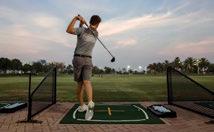
3 minute read
Your Turn
1 2
3
WATCH THE VIDEO

▶ Mike brings this lesson to life at
golfdigestme.com 4
Your Turn Power and accuracy are bedfellows of a good backswing rotation
IF YOU ARE struggling for distance or hitting consistently wayward shots, poor rotation could be the cause. This is often triggered in the backswing where many amateurs move away laterally, almost as if they are sliding off the ball. This can be seen in the image right where my right hip has pushed into the vertical stick next to my right foot. You can see the correct positioning of the vertical stick in images 2 and 3.
If I rotate and spiral my body correctly, my right shoulder and chest will not slide to the right. Instead, it will turn around, up and behind me. This in turn will move the hip back and around slightly. Instead of hitting the vertical stick, the correct rotation of the body will maintain a gap between the hip and stick (image 4).
In these series of images, I have placed a second stick in the belt loops of my shorts. As I make my practice swing with a good rotation of the body, I should see the stick at my waist turn in slowly towards the ball - normally up to about 45 degrees from its start position which is parallel to the target line. When the top half of the body performs the correct, strong spiral in the backswing, the hips will need to turn to allow that backswing to be completed. Trying to keep the hips still in the backswing will not help to produce power and will almost always result in an incomplete backswing.
Another use for the stick in the belt loop is to help understand how the body should rotate back to the ball. With the stick rotated about 30/45 degrees behind my toe line (image 1), this is a great feel for a powerful impact position and one that we should look to replicate during some

slow-motion practice swings. You can hit balls with the stick in the belt loops but start slowly and try to replicate the posed position at impact. This is a great way to feel the legs and lower half of the body initiate our move back to the ball.
Michael Kinloch is Head Professional at Dubai Creek Golf & Yacht Club’s Peter Cowen Academy Dubai. For more information, visit dubaigolf.com
toptracer range
▶ At the Peter Cowen Academy at Dubai Creek, we are now fortunate to have Toptracer range at our disposal, the same ball-tracking technology used to track the shots of the world’s best players on TV.
With the help of cameras mounted around the range and 21-inch monitors in each hitting bay, the technology off ers amateurs some very useful data during practice sessions. It’s not uncommon to see players improve their ball speed by fi ve miles per hour based on a stronger and more full turn away from the ball, a data point Toptracer monitors on every shot. That’s immensely gratifying for the player and us as teachers, as are the Toptracer Range games and modes suited for all ages and skill levels. The system is amazingly accurate and great fun to use. In virtual golf, you can take on friends over a selection of world-famous courses, challenge them to nearest the pin competitions or longest drive challenges. Serious golfers can use the practice module to hone their skills, keep track of their distances and upload data to their Toptracer profi le. It will really add a fun dimension to practicing at the Creek”.











